ROCHA, Artur Batista de Oliveira [1]
ROCHA, Artur Batista de Oliveira. Romeo and Juliet in Cordel: Contributions to Literature. Multidisciplinary Scientific Journal. Edition 8. Year 02, Vol. 05. pp. 144-157, November 2017. ISSN:2448-0959
ABSTRACT
The study of the Portuguese Language seeks to contemplate the contemporary theoretical-methodological discussions about the process of teaching and learning of the mother tongue by taking the text and the textual genres as objects of teaching and learning. Play is a human need that provides the child's interaction with the environment in which he lives, being considered as a means of expression and learning. The objectives of this work were to improve students' written and oral expressions. Students are able to overcome difficulties in written and oral expressions when the chosen activities must have meanings for them, so the statement becomes clearer to be understood when referring to the familiar situations or their everyday life.
Keywords: Ludicidad, Literal Genres, Cordel Literature.
1. INTRODUCTION
A traditional classroom where the teacher is the source of knowledge and students only ships to be filled with no such factors as: "surprise" is to surprise students with the aim of increasing their attention and encouraging their participation in the discovery of solutions to problems or mathematical theorems. Another factor that is not present is trust, this should encourage student self-confidence, to master the concepts, skills, resources, strategies to achieve success in the learning process (BORIN, 2007).
According to Oliveira (1996), socio-interactionism based on Lev Semenovitch Vygotsky's theory is a teaching and learning process that attributes to the educational process a historical and social dimension. It is in the social environment to which it belongs and in the exchanges with the other symbolic with the other people that the individual learns and constructs representations about himself and about the world with which he interacts. In this conception, pedagogical practices are measured by the relationship between different stakeholders (teacher-student, student-student and others), since the learning is centered in the different ways in which the subject learns, how it interacts with its cultural and social environment and how appropriates the cultural goods produced in it. In order for this approach to take place in the school context, which is responsible for the didactic transposition, there is a need to define the roles of the teacher (mediator), the student (the knower), the activities (mobilizer), the error resizing pedagogical practice) and evaluation (providing information for the improvement of the educational process) of the teaching and learning process.
With the publication of the National Curricular Parameters (1998) for elementary education and with the contribution of knowledge relevant to the production of knowledge in the school, coming from universities and
research, the teaching of the mother tongue has been based on the study of textual genres. The adoption of the text as a basic unit and of textual genres as objects of teaching and learning triggered a relevant and significant research activity, aiming to describe a considerable diversity of genres from the heterogeneous texts as exemplars and source of reference of a certain genre (KLEIMAN , 2005).
The study of the Portuguese Language seeks to contemplate the contemporary theoretical-methodological discussions about the process of teaching and learning of the mother tongue by taking the text and the textual genres as objects of teaching and learning. The work with the textual genres presupposes the analysis of the text and discourse of which it is product, besides a description of the language. It also seeks to "answer questions of a sociocultural nature in the use of the language", "to the treatment of the language in its daily life in the most diverse forms" (MARCUSCHI, 2008).
These presuppositions impose on education respect for diversity and the search for knowledge that can generate, through the study of the text, new cognitive and communicative forms, adapted to the needs of interaction. The development of the linguistic competence of the student is not based on the exclusivity of the technical domain of use of the language legitimized by the norm, but above all in the performative competence, that is, in knowing how to use the language in subjective or objective situations that require degrees of detachment and reflection on contexts and the status of interlocutors (BRAIT and ROJO, 2002, p.185).
Language is, therefore, a human, social and historical activity. Human interactions, which are manifested by different languages (verbal and nonverbal), maintain an intrinsic relationship with the language. In turn, "the use of language takes place in the form of concrete and unique statements (oral and written) emanating from the members of one or another sphere of human activity" (BAKHTIN, 1997, p.158). The statements are products of verbal interaction, always presupposing the presence of an enunciator (the speaker, the writer) and a receiver (the one who listens, who reads). They are always historically situated, that is, they happen in a specific place and at a given time, and are therefore unique and singular. "These statements, although individual, are in constant dialogue with existing statements, resulting from this dialogical process the infinity of discursive genres (BROCKART, 1999, p.69)." The objectives of this work were to improve students' written and oral expressions.
2. LÚDICO EDUCATION
Play is a human need that provides the child's interaction with the environment in which he lives, being considered as a means of expression and learning. The ludic activities enable the incorporation of values, cultural development, assimilation of new knowledge, the development of sociability and creativity. Thus, the child finds the balance between the real and the imaginary and has the opportunity to develop in a pleasurable way (PINTO and TAVARES, 2010).
According to Kishimoto (1994), the playful is an instrument for the development of language and the imaginary, as a means of expressing the spontaneous or natural qualities of the child, a moment to observe the child expressing through him his psychological nature and his inclinations. Moment, this, to learn important values, socialization and the internalization of concepts in a meaningful way. The ludic in the classroom happens to be a space for re-elaboration of experiential knowledge and constituted with the group or individually. Thus, the child becomes the protagonist of his social history, the subject of the construction of his identity, seeking a social self-affirmation, and giving continuity in his actions and attitudes, enabling the awakening to learn.
Playful activities ensure meaningful learning for the child with learning difficulties, as well as pleasure, socialization, respect, individuality. For the child will be learning in its rhythm, creating hypothesis, coming to the conclusion and elaborating its rules. Hitting and making mistakes with your own mistakes and picking up to hit again. Thus, their learning will be meaningful and will lead to learning that will never be forgotten (PINTO; TAVARES, 2010).
3. TEXTUAL GENRES
Working with textual genres are relatively stable forms of statements that make communication and action in the world possible (BAKHTIN, 1997; BRONCKART, 1999), it makes it possible for students to explain that in everyday life verbal interactions occur by means of statements that are made taking into account certain restrictions of theme, compositional structure and style ie in some genre. The transposition of this concept into the classroom is a very important step, since it goes beyond the concept of teaching and learning that conceives the language only as a means of communication: it is based on the assumption that language is a discursive activity, located historically , process of interaction between subjects in a given context (BAKHTIN, 1997).
According to Abreu-Tardelli (2003), teaching a genre is not only teaching how to communicate, but also and especially to form subject agents of the world and in the world, who will transform it and who will be transformed by it as well.
The textual genres are as varied as the spheres of social life or
institutional (legal, religious, political, journalistic, advertising, literary …) in which the practices that organize the speeches are given (MARCUSCHI, 2008).
In the exploration of textual genres as an object of study, it is of fundamental importance to consider work with reading, seen as an interactive and complex activity of sense construction involving author-text-reader. This is accomplished not only on the basis of the linguistic elements of the text surface, of its form of organization, but also with the mobilization of a set of knowledge, experiences and knowledge that the reader brings from his knowledge of the world (KOCH and ELIAS, 2007 ).
In the teaching of the mother tongue, reading is not a means to reach knowledge, but rather a content to be taught that presupposes a systematic and planned work like the other contents, considering elements that propitiate the development of its reading comprehension and favoring the formation of subjects who, progressively, can read in an autonomous way. Therefore, it is important to guarantee access to gender diversity (MARCUSCHI, 2008). In this respect, the teacher plays a fundamental role in the expansion of the students' repertoire, offering texts to which they would not have access by other means. In order to optimize didactic time and to ensure that reading is not relegated to its procedural dimension, it is fundamental to establish reading routines, with the definition of a moment for reading in the development of the class with the genres previously chosen by the teacher (KLEIMAN, 2005).
In this practice, the reading strategies aim to help the work of understanding and interpreting texts, so that it is even more significant. Thus, as authors such as Solé (1998) and Koch and Elias (2007) attest, reading should be valued as an instrument of learning, access to information and pleasure.
4. LITERATURE OF TWINE
According to Luyten (2007) cordel literature is an art considered poetry, narrative printed and sold in leaflets. It arrived in Brazil in the eighteenth century, through the Portuguese, having strong circulation mainly in the Northeast region of Brazil being the fertile barn of the cord.
According to Abreu (1999) in cordel literature the Northeastern life is the inspiration for the production of the leaflets. Unlike other literary products, the string is marketed in the street, in free-trade, in the midst of other goods, or hanging on twine, just where the string came from, that is, literature that hangs on the string to be offered to consumers. According to Cavignac, (2006) the main authors of cordel literature are:
- Apolônio Alves dos Santos: Author of the booklet "Maria Cara de Pau and The Prince Gregoriano", released in 1949, was a mason and participated in the construction of Brasília before living his poetry. A native of Guarabira (PB), he wrote about 120 pamphlets, including the famous "Carioca Discussion with the Pau de Arara".
- Blind Aderaldo: The popular poet, born in Crato, Ceará, was inspired by life in the northeastern backlands. When losing vision in an accident, he discovered that he had talent for rhyming, became a singer known in the region and even won a monument in his honor, located in Quixadá, Ceará.
- Firmino Teixeira do Amaral: A famous Piau poet, Amaral was one of the main authors of Editora Guajarina and one of the creators of a peculiar style of cordel literature, the tongue-and-groove. He was the author of "Fighting Blind Aderaldo with Zé Pretinho do Tucum", a letter that was later recorded by Nara Leão and João do Vale.
- João Martins de Athayde: He was the main editor of Brazilian cordel literature. Born in 1880 in Cachoeira da Cebola, Paraíba, Athayde was a peddler and father of 25 children. In Recife, she took a nursing course and then bought the project that would become her publishing house. Later, he began to write his own works, as "Serrador and Carneiro".
5. WILLIAM SHAKESPEARE
According to Formiga (2016) William Shakespeare was born in Stratfor Upon Avon (England) on April 23, 1554, died on the same date in 1616, at age 52. In 2016, his death was 400 years old.
Shakespeare was the author of 38 plays (among historical, comedies and tragedies), such as Hamlet, Romeo and Juliet, Othello, Macbeth, A Midsummer Night's Dream, Richard III, King Lear, The Taming Shrew, The Storm, and others. Off the stage, he wrote 154 sonnets and a variety of other poems. Although these stories have been written for centuries, they are still current and bring themes that are part of reality to this day (FORMIGA, 2016).
One of Shakespeare's most acclaimed plays is Romeo and Juliet, this tragedy, elaborated between 1591 and 1595, is not only significant for focusing on forbidden love between two young people in Renaissance Verona, but also for denouncing hypocrisy and social conventions, interests and the thirst for power, elements that inevitably engender intolerance and condemn the noble sentiment that springs from the hearts of Romeo and Juliet (WATAGHIN, 1996). The lovers meet at a party promoted by the Capulets leader, the young woman's father. Romeo, of course, was not invited but, believing himself to be in love with Rosaline, one of the girls present at the event, hides under a clever disguise and goes to the celebration. Once, however, that he encounters Juliet, the image of the other girl disappears from his heart, and in him now there is only room for the unknown girl. Soon after, they discover that they belong to families that hate each other.
Shakespeare's play has had numerous montages and versions over time. The story was also transposed to the screens of the theaters. The two best-known versions are Franco Zeffirelli, 1968, starring Leonard Whiting and Olivia Hussey; and that of Baz Luhrmann, in 1996, played by Leonardo DiCaprio and Claire Danes, which takes place in the present world (FORMIGA, 2016).
6. DEVELOPMENT
The work was developed from October to December 2016 for the Portuguese language subject in a 4th year of elementary school I in a basic education school located in the municipality of Cosmópolis.
The methodology used for didactic sequencing was based on
Dol and Schnewly (2004) with the steps described below:
1-) Cordel Literature: From a dialogic exposition the characteristics of cordel literature were presented and as a tool of this lesson an animation of sung string was shown: O Cangaceiro (https://www.youtube.com/watch?v = PXa3eYOh96I & t = 103s). Then a conversation was held to verify the knowledge acquired by the students and also to solve doubts.
In the second class the students produced a text production which consisted of writing a string poetry, telling any story of their free choice. However, in the third class the delivery of the corrected activity was performed and the students rewritten the poetry observing and discouncing the errors observed in the correction.
2- Romeo and Juliet (Work of William Shakespeare): From an expositive dialogue about writer William Shakespeare and his main works. Then the students carried out a double research in the laboratory of computer science on the work Romeo and Juliet and wrote down the data that more they called the attention.
In the second class each pair presented to the class the data of the research that wrote down and explained the facts that called attention in the work.
3-) Making the cordel books: After the students acquire knowledge about cordel literature (step 1) and the work Romeo and Juliet (step 2). The students formed doubles for writing the string books in three classes, in which they chose a story for Romeo and Juliet with illustrations, such as the M.G. and M. (Figures 1, 2, 3, 4, 5, 6, 7 and 8). In the fourth class the books were corrected and given to the students to make the necessary adjustments.
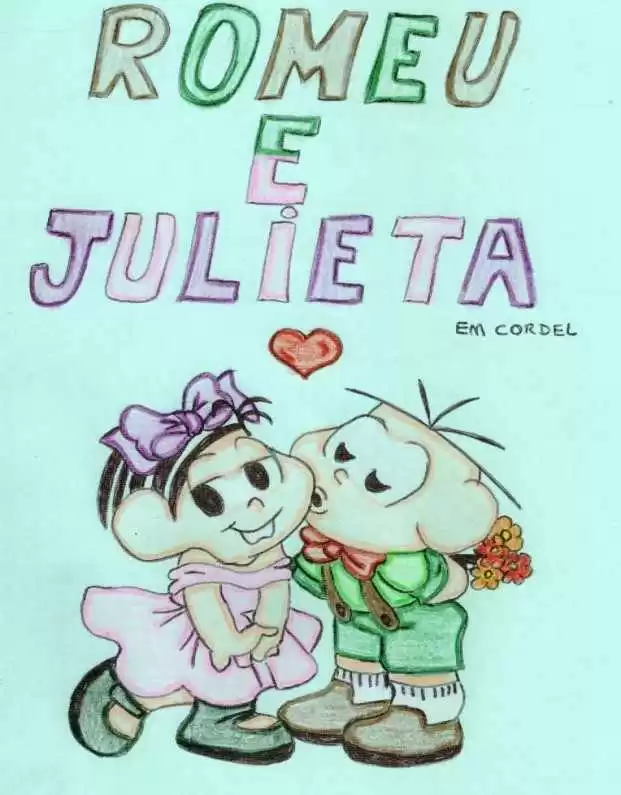
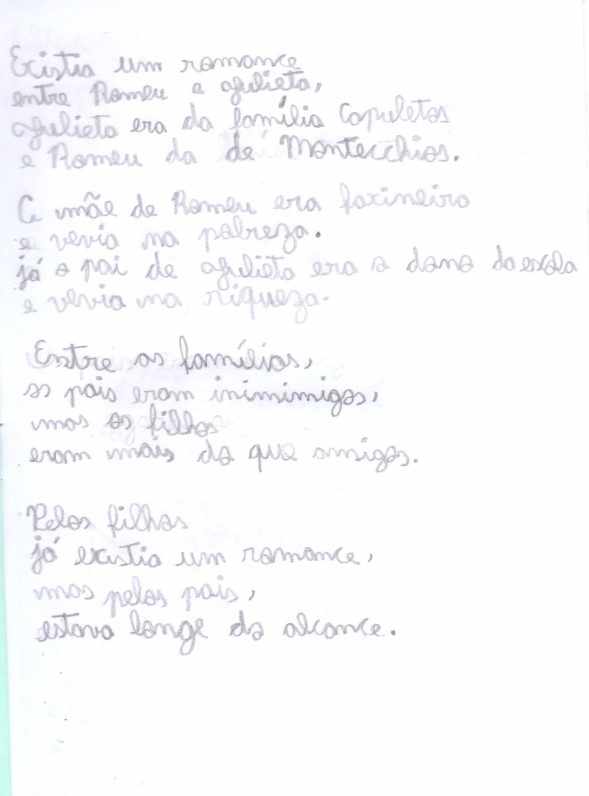
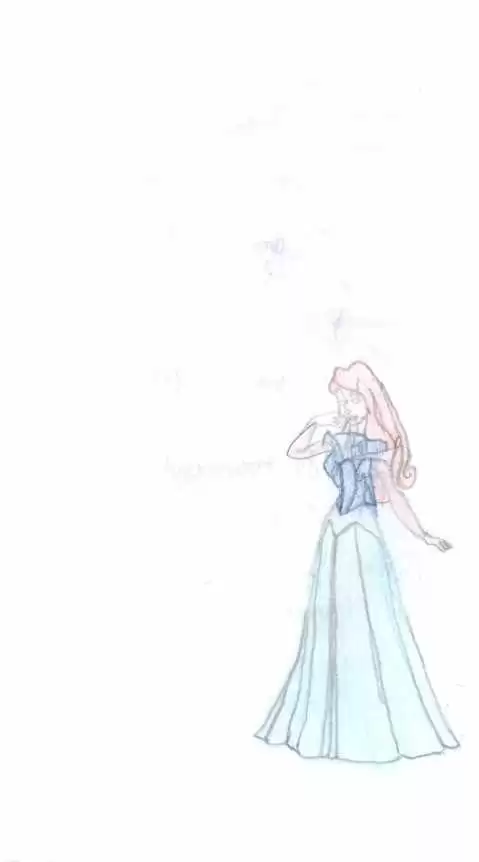
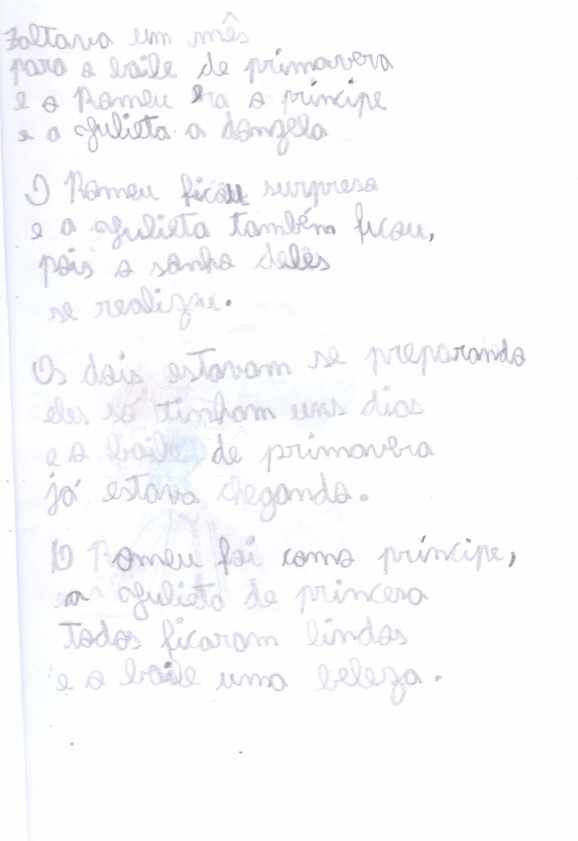
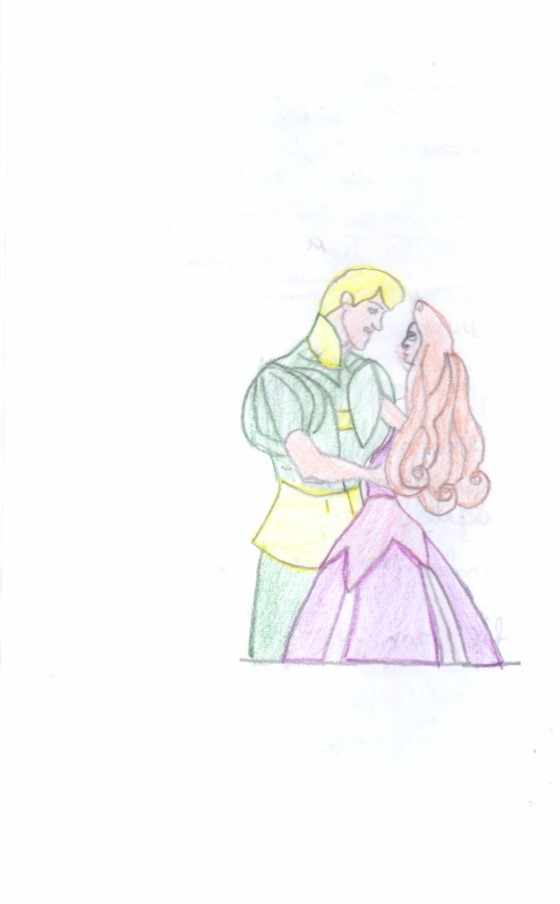
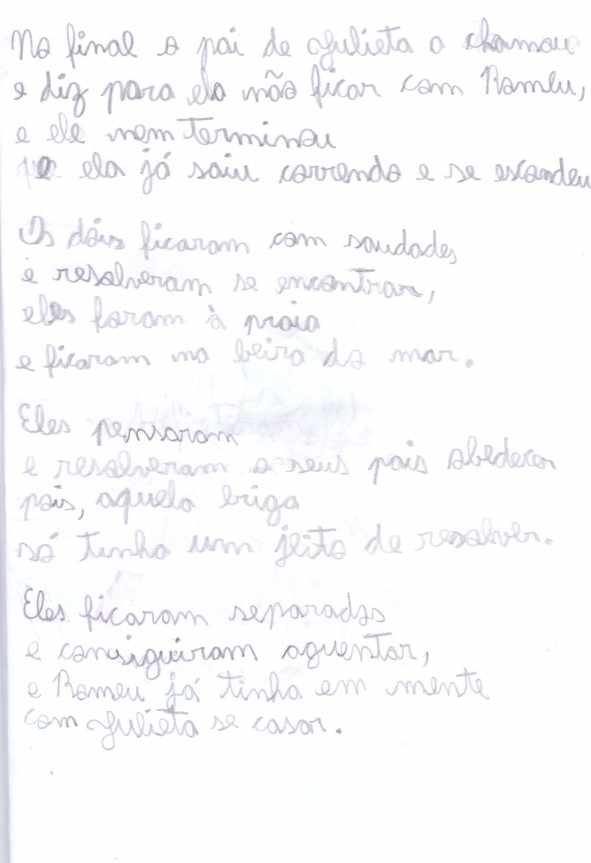
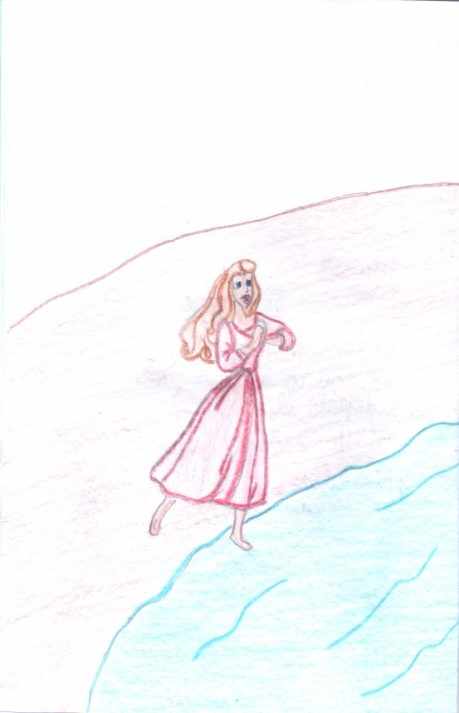
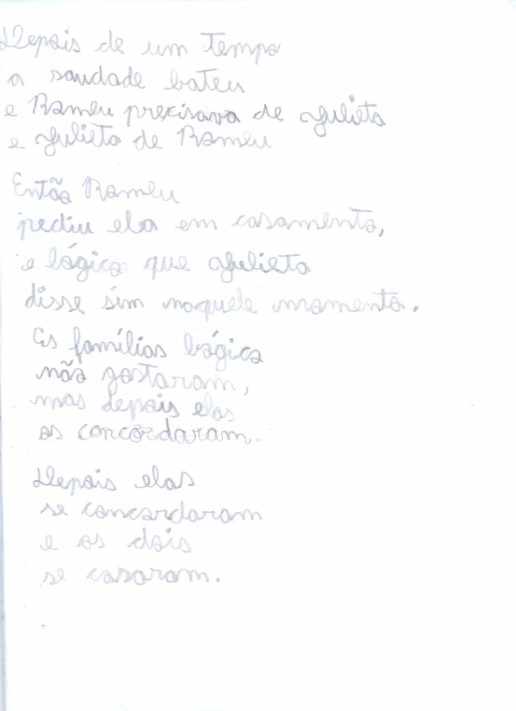
7. RESULTS AND DISCUSSION
With this proposed practical activity it was observed that the students were able to perform it with greater ease and this way the mental block that occurs during the exercises of production of conventional text as observed by Marcelino (2002) was overcome. However, for Mello et al. (2014) the application of play activities is a great educational tool for young people, adults and children because it proves and benefits the imagination, being used by the science of psychic and behavioral phenomena in some tests.
In the diagnostic evaluation of text production applied to the class it was observed that the students overcame most of their difficulties involving mental blocking, paragrafting, spelling, cohesion and coherence. According to Nunes (2004) learning through applications of play activities, which are in fact useful for the student, is interesting, not because he needs to do well in the discipline, but because the interest was aroused. However, it is necessary to understand that the factors of the subject and the circumstantial factors do not act separately, since there is in the environment in which the child lives several reasons to install difficulties that, at first glance, seem to belong to the subject and also there are in the subject several characteristics that the influence of this or that circumstance of their environment. Thus, if physical, neurological, cognitive or affective conditions can make learning difficult, we must not forget that they can also be provoked or accentuated by the child's environment. And the medium does not only understand the family, but also the school, the community, the customs, the cultural characteristics that propitiate it, or not, to think and act for itself, to try, to risk to err, to correct, to err again , without fears and without guilt (TEZANI, 2004).
A significant improvement in the ability of the students' oral expression was also observed. For Bakhtin (1997) the meaning of the word refers to the actual reality in the real conditions of verbal communication. It is for this reason that we not only understand signification as a word of the language but also adopt an active responsive attitude towards it (sympathy, agreement, disagreement, stimulation to action). Expressive intonation does not belong to the word, but to the utterance.
Final considerations
Most of the students did not know the cordel literature and with these activities they had a significant cultural gain. For Marinho and Pinheiro (2012, p. 3), "it is important that cordel literature be perceived as a cultural production of great value and that life experiences must be known, preserved and increasingly integrated."
With this activity was observed a greater interaction between the students and also with the teacher. According to Rocha et al. (2016) school and teachers are also important mediators because they interpose themselves between the child and the larger social world and are responsible for teaching them contents, for making them learn, for developing their intelligence and affectivity. The school intervenes with new materials and objects to think, taking advantage of (some more and less) the experiences brought by the child. Like the family, the school selects what it considers important to be learned, filters, cuts, and "takes the reins" of the learning process of its students. Whatever the methodology is, one thing is sure: at school intervention takes place, the central objective of which is to learn selected contents as important for the future life of the child in the social world to which it belongs.
With the application of this activity a significant improvement in the capacity of concentration, of discernment and of logical reasoning was detected. According to Vygotsky (1989) the playful influence on the student's development, teaching him to act correctly in a given situation and stimulating his ability to discern. However, for Jesus (2007, p.10), "the teacher should instigate the student, create conflicts and contradictions through questions or problems or narratives that stimulate them to think". The chosen activities must have meanings for them, so the statement becomes clearer to be understood when referring to the familiar situations or their everyday life.
BIBLIOGRAPHIC REFERENCES
ABREU, M. Stories of twines and leaflets. Campinas: Literature Market ALB, 1999.
ABREU-TARDELLI, L. S. Elaboration of didactic sequences: teaching and learning of genres in English. English language teaching materials: elaboration and evaluation, at the II International Congress of All Letters: Languages, from the Mackenzie Presbyterian University, held from October 6 to 9, 2003.
BAKHTIN, M. The genres of discourse. In: Aesthetics of verbal creation. São Paulo: Martins Fontes, 1997.
BORIN, J. Games and problem solving: a strategy for math classes. 6.ed. São Paulo: IME-USP, 2007.
BRAIT, B .; ROJO, R. Genres: tricks of text and speech. Collection Languages and Codes. São Paulo: Associated Schools, 2002.
BRAZIL. National Curricular Parameters: Portuguese Language. Brasília: MEC, 1998.
BRONCKART, J. Activity of language, texts and discourses: by a sociodiscursivo interactionism. São Paulo: Educ, 1999.
CAVIGNAC, J. Cordel literature in northeastern Brazil: from written history to oral history. Natal: UFRN Publishing House, 2006.
DOLZ, J .: SCHNEUWLY, B. Genres and progression in oral and written expression. Elements for reflections on a Swiss experience (francophone). In: "Oral Genres and Written in School". Campinas: Literature Market; 2004.
FORMIGA, M. Shakespeare, in prose and poetry. Revista Nordeste, September issue, p.58, 2016.
KLEIMAN, A. Presentation. In: DIONISIO, A. P .; MACHADO, A. R; BEZERRA, M.A. (Orgs.). Textual genres and teaching. 3. ed. Rio de Janeiro: Lucerne, 2005.
KISHIMOTO, I. M. The game and the infantile education. São Paulo: Pioneira, 1994.
KOCH, I. V .; ELIAS, M.E. Read and understand: the meanings of the text. São Paulo: Context, 2007.
JESUS, M.M. Mathematical language in youth and adult education (EJA). Brasília: UCB, 2007. Course Completion Work (Degree in Mathematics) – Faculty of Education. Catholic University of Brasília, Brasília.
LUYTEN, J. What is Cordel Literature. São Paulo: Brasiliense, 2007.
MACEDO, L .; PASSOS, N.C; PETTY, A. The Games and the playful in school learning. Porto Alegre: Editora Cortez, 2005.
MARCELLINO, N. C. Pedagogy of animation. Campinas: Papirus, 2002
MARCUSCHI, L. A. Textual production, gender analysis and comprehension. São Paulo: Parabola Editorial, 2008.
MARINHO, A. C .; PINHEIRO, H. The cord in daily school life. São Paulo: Cortez, 2012
MELLO, R.O .; HACHMANN, M.S .; SITNIEWSKI, V.C .; ALMACABÚRIO, D.F.S; DUARTE, M.L .; SEGANFREDO, V .; SOUZA, I.M.V. Ludivity in teaching Portuguese in the final grades. Unoesc & Ciencia, v.5, n.2, p.181-190, 2014.
NUNES, A. R. S. C. A. The Lúdico in the Acquisition of the Second Language. (2004) Available online at: <http://www.linguaestrangeira.pro.br/artigos_papers/ludico_linguas.htm>. Accessed on 15 Feb 2017.
PINTO, C.L .; TAVARES, M.H. The ludic in learning: learning and learning. Revista da Católica, v.2, n.3, p.226-235, 2010.
ROCHA, M.F.J .; BITTAR, M .; LOPES, R.E. The school and community mediator teacher: a practice under construction. Electronic Journal of Education, v.10, n.3, p.341-353, 2016.
SCHNEUWLY, J .; DOLZ, B. Oral and written genres at school. Campinas: Literature Market, 2004.
SOLÉ, I. Reading strategies. Porto Alegre: ArtMed, 1998. WATAGHIN, L. (org). Romeo and Juliet and other Renaissance tales. Translation by Nilson Moulin. Rio de Janeiro: Imago, 1996.
TEZANI, T. C. Rodrigues. The game and the processes of learning and development: cognitive and affective aspects. 2004. Available at: <http://www.psicopedagogia.com.br/artigos/artigo.asp?entrID=621> Accessed on: 10 feb. 2017.
[1] Graduated in pedagogy and specialist in: literacy and literacy and institutional psychopedagogy.















